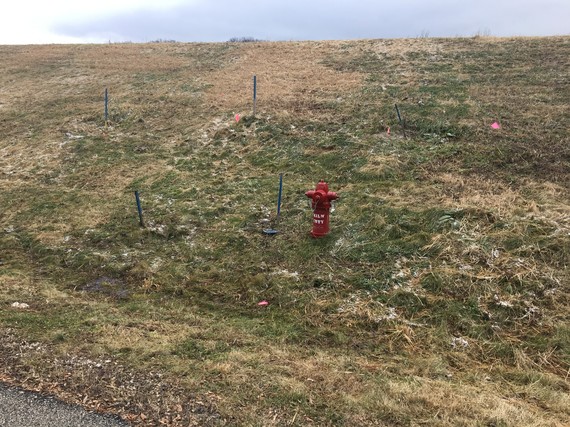 Hydrant installed on dam unbeknownst to dam owner. The hydrant has since been relocated due to potential impacts to the embankment. Photo Credit: Gestra, Inc. via Milwaukee Metropolitan Sewerage District
.
Occasionally, earthen embankment dams are used for vehicular access across streams. These may be public roadways, private driveways or even unimproved ways in relatively undeveloped locations. These may also seem like a convenient way to carry utilities such as electric lines, telecommunication lines, sewer and water lines or even gas lines across a stream.
However, placing utilities within an earthen dam embankment creates a discontinuity within the dam’s structure that presents opportunities for settlement, shifting, formation of seepage paths and other embankment integrity issues. This may reduce the dam’s ability to hold water and could even lead to weakening and slumping of the earthen section and subsequent failure of the dam.
Please consider the following:
- Location: If possible, keep utilities out of a dam altogether. Utilize directional drilling, casing pipes, overhead lines, etc. in a different location upstream or downstream of and separately from the dam.
- Approval: If circumstances absolutely require that utilities be installed within a dam, the DNR Water Management Engineer (WME) will need to review and approve the proposal prior to construction. Additional discussion with the WME about the risks and design considerations, as discussed below, can also be useful.
- Utility trenches within embankments: If trenched-in sections need to be installed within the dam, be aware of internal material zones such as clay cores, filter layers, etc. Trenching can interrupt or destroy the integrity of these zones. Quality control over trench backfill materials and methods are important. Backfilling should utilize a similar material gradation and compaction standard as the surrounding embankment fill and trenches should be kept as shallow as possible, so that there are fewer conditions where the saturation zone within the embankment intersects with the trench. To do this, review original dam construction design data to determine where the saturation zone lies and avoid these areas with trenches. If the trench intersects the saturation zone, a revised seepage analysis may be needed to properly assess the potential impacts. Additionally, trenches oriented upstream to downstream (usually termed “penetrations”) need special consideration. This orientation coincides with the direction of potential seepage, and therefore additional measures such as trench plugs, conduit collars, filter layers or other internal drainage features may need to be considered in an attempt to preserve the integrity of the dam.
- Pressurized lines: Water, sewer forcemains, natural gas, and other pressurized liquid/gas lines can pose an additional risk. If the line fails due to settlement, shifting, joint separation, freezing or other factors, the pressurized gas or liquid will rupture and take embankment material with it. Measures such as encasements, pressure reduction, and shut-off valves can provide mitigation to some extent, but failures of these types of lines can be especially problematic, and thus should be avoided.
- Overhead lines: Minimize the number of poles that are within the embankment.In an overtopping event, the interface between the pole and the ground is a spot that invites scour, which can lead to incising erosion (headcutting). Additionally, if the dam is built with internal material zones, inserting or excavating for a pole may interrupt the integrity of the internal embankment structure. Review original dam construction plans and/or available record drawings, so that important earth fill zones can be avoided.
- Guidelines for utility construction within embankments can be found in design literature from the ACOE, Bureau of Reclamation, FEMA, USDA and others.
DON’T be fooled into believing that a utility within a dam embankment is minor or trivial. Best practice is to keep utilities out of dams. If there is a design proposal for a utility within a dam, or if a utility is discovered within a dam, be sure to contact the DNR Water Management Engineer assigned to the county in which the dam is located.
|